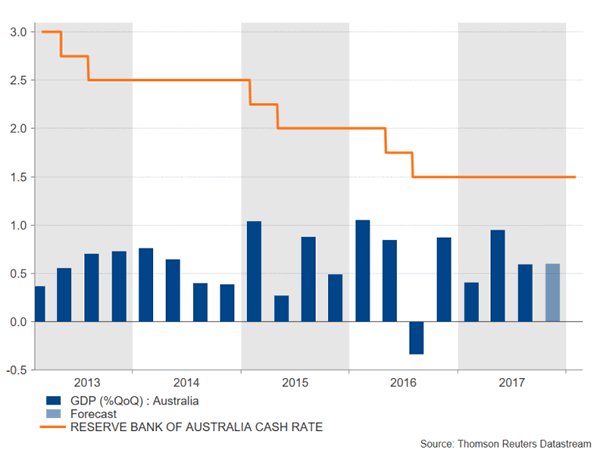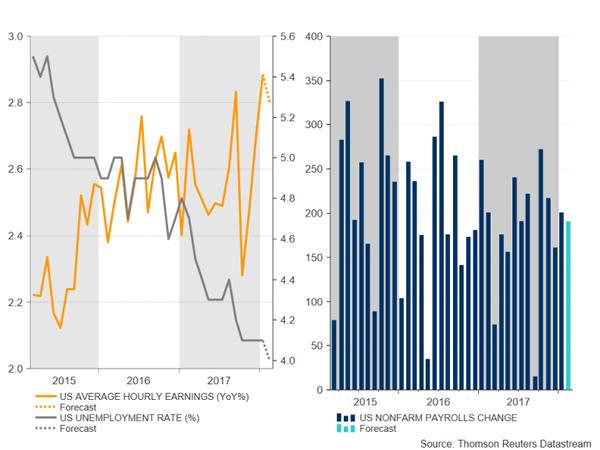The coming week looks set to be dominated by central banks as policymakers in Europe, Canada, Australia and Japan gather for their corresponding policy meetings. Economic data shouldn’t escape the headlines however as Australian GDP, Chinese trade figures and US and Canadian jobs reports will be eagerly awaited. However, early in the week, politics will be setting the mood, particularly for the euro as Italians go to the polls to vote for a new government on Sunday and Germany’s SPD party publishes the results of the postal vote by its members on whether to approve the coalition deal struck with Chancellor Merkel’s CDU party.
Important week for Australian dollar
Fourth quarter growth figures and the Reserve Bank of Australia’s policy meeting will put the spotlight on the aussie next week but there will also be plenty of other data out of Australia to keep aussie traders busy. The week will start with January building approvals and Q4 business inventories on Monday. After this week’s disappointing capital expenditure numbers, another weak reading of a GDP component would raise the risk of a negative surprise in Wednesday’s growth figures. On Tuesday, January retail sales will be watched to gauge the strength of Australian consumer spending at the start of 2018, while the net exports contribution for Q4 will be the final barometer for the GDP release the following day. Rounding up the week will be January trade numbers on Thursday.
Australia’s economy is forecast to have expanded by 0.6% quarter-on-quarter in the final three months of 2017, the same rate as in the prior period. The RBA will likely already have a sneak preview of the GDP data when it meets on Tuesday. The central bank is widely expected to keep its cash rate unchanged at 1.5% as inflation and wages remain subdued. Weak GDP growth could prompt the RBA to tone down its recent upbeat view but will likely take comfort from the aussie’s 5% slide versus the US dollar from January’s 2½-year high.

Apart from domestic factors, the aussie could face additional volatility coming from Chinese indicators. The latest trade data out of China on Thursday will be eyed to see how exports and imports withstood the long Lunar New Year holiday in February. Friday’s consumer and producer prices indices could also show some impact from the new year celebrations.
Bank of Canada and employment report may add to loonie’s woes
The Canadian dollar slid to a 2-month low this week, with USD/CAD breaking above the 1.28 level as the US currency regained some positive momentum. While the February jobs figures may provide the loonie a helping bump up, the Bank of Canada meeting poses a downside risk. The Bank of Canada’s latest policy decision is due on Wednesday and after three rate hikes in the past eight months, the Bank could be headed for a pause. The latest data for January was mixed with employment and retail sales numbers missing estimates by a wide margin but inflation unexpectedly picking up. Comments from BoC policymakers have been more cautious of late and markets are not fully pricing in another rate hike until July. If the BoC reiterates its data-dependent view, the loonie may continue to drift lower. However, a robust employment report on Friday could go some way in bringing rate rise expectations forward to May.
No surprises expected from Bank of Japan
The Bank of Japan will be another central bank holding a monetary policy meeting in the next seven days and like the RBA and the BoC, it is not expected to make any tweaks to its policy even as the Japanese economy continues to improve. There will be more evidence of this strength on Wednesday when revised GDP figures for the fourth quarter are released. GDP growth is forecast to be revised upwards from 0.5% to 0.9% on an annualized basis. However, with corporate Japan unwilling to pass on higher earnings to employees, there’s been insufficient progress in wage growth and consumer price inflation for the BoJ to start reducing its massive stimulus program. An appreciating yen over the past month also stands in the way of this progress, though BoJ Governor Haruhiko Kuroda has already started to look ahead with recent talk of policy normalization. Such language is unlikely to be included in Friday’s decision statement however, when the Bank concludes its two-day policy meeting. The BoJ is expected to maintain rates at -0.1% and the target on 10-year Japanese government bond yields at 0%.

ECB to drop easing bias?
The European Central Bank will be among next week’s highlights as it holds its March policy meeting. Economic data will not be sparse but are unlikely to generate significant moves in the euro. The Eurozone sentix index, final Markit PMIs and retail sales figures will kick-off the week on Monday. On Wednesday, the third estimate of Q4 GDP growth is published but no revision to the prior 0.6% q/q reading is being forecast. German data will also attract attention with industrial orders due on Thursday, and industrial production and trade numbers out on Friday (all for January).
Markets’ focus will instead be ECB President Mario Draghi’s latest views on the Eurozone economy and inflation at his post-meeting press conference on Thursday. No change in policy is expected from the ECB but a tweak in the Bank’s statement is possible according to a Reuters report citing ECB sources. The farthest the ECB is likely to go this month is to drop its pledge to increase its asset purchases if necessary, with a bigger decision on updating the Bank’s forward guidance not anticipated before April.
Flash CPI estimates out this week showed euro area inflation slowed to a 14-month low of 1.2% in February, supporting the case for a very gradual exit from QE. The single currency could retreat further from last month’s 3-year peaks if Draghi repeats the dovish stance when he testified before the European Parliament earlier this week.
UK services PMI unlikely to inspire sterling
After sliding to a 7-week low just above $1.37, the pound may struggle to find much support from the few data releases coming out of the UK next week. Services activity is expected to edge up marginally in February, with the Markit/CIPS PMI rising from 53.0 to 53.3 on Monday. Industrial and manufacturing output will be the next major data on Friday. After a sharp slowdown in December, both indicators are forecast to rebound in January. Industrial production is expected to jump by 1.1% month-on-month in January, while manufacturing output is forecast to grow by 0.2% m/m. January trade figures are also due on Friday.
US pay growth back in focus
Just as markets were beginning to recover from the turmoil set off by the stronger-than-expected wage growth figures in January’s US jobs report, President Trump’s decision to impose steel and aluminium tariffs has cast fresh cloud over the outlook, putting markets in a vulnerable footing from any surprises in Friday’s nonfarm payrolls report. Ahead of the jobs data, the ISM non-manufacturing PMI for February will be eyed on Monday, followed by January factory orders on Tuesday and the trade balance on Wednesday.
February’s jobs report is expected to show another month of solid gains in nonfarm payrolls, with a consensus of 190k jobs being added to the US economy. The unemployment rate is forecast to tick down to 4.0% in February from 4.1%. However, the annual growth in average hourly earnings is forecast to ease slightly to 2.8% from January’s 8½-year high of 2.9%. A stronger reading could exacerbate the concerns about inflation taking off this year, which would lead to a more aggressive Fed tightening. Without a positive wage component though, a broadly strong report may not impress dollar bulls, especially against the backdrop of rising risks of a trade war.












